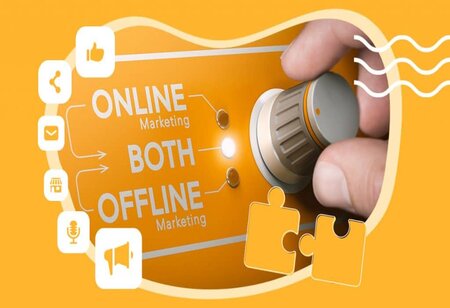Benefits of Integrating Offline and Online Marketing Together
By Tanuja Akkannavar
 In today's world, people want to have access to knowledge via a variety of means, including both online and offline, anytime and anywhere they choose. As a result, they are looking for a balance between convenience and personal service while purchasing things online as well as offline. In order to develop a trustworthy and unified brand, you must integrate offline and online marketing efforts to guarantee that your audience's requirements and desires are met at every peripheral device.
In today's world, people want to have access to knowledge via a variety of means, including both online and offline, anytime and anywhere they choose. As a result, they are looking for a balance between convenience and personal service while purchasing things online as well as offline. In order to develop a trustworthy and unified brand, you must integrate offline and online marketing efforts to guarantee that your audience's requirements and desires are met at every peripheral device.
If you want your clients to have a positive and trusting experience, you need to have a consistent and coherent online and offline experience. Digital technology has transformed the way we interact with the world around us. In light of these facts, it's no surprise that most firms are turning to the internet for their advertising strategies. Online marketing has been a popular approach for companies to promote their brands and products since it provides a broad variety of advantages.
Using social media and other digital marketing strategies has numerous advantages, but firms should not forget the value of traditional forms of advertising. You can't go wrong with a marketing approach that incorporates both offline and online methods, therefore you won't lose out on any potential customers. You'll be able to convey your message more effectively if you use a variety of ways instead of concentrating on one.
Marketers that want to be successful must be able to see themselves in the shoes of their target audience in order to fully grasp how people get information and use it. Increase your chances of success by integrating both digital and conventional marketing strategies. Following are some of the benefits of integrating offline and online marketing strategies together:
1. Stand Unique –
Use both online and offline marketing activities to get an advantage over your competition. Your brand will benefit from the best of all worlds while your competitors focus only on the digital realm of advertising. It's a good idea to keep your digital journal look the same as your advertising pamphlets in order to help consumers and potential clients recognize your company's brand.
2. Increasing Brand Awareness –
Branding consistency is an essential part of creating a connection between offline and online marketing, as it helps to develop more unified campaigns. This implies that organizations need to use the same trademark, designs, styles, colours, and trends both on online and offline marketing channels.
It's important for a company's website, business cards, and other marketing materials to have a visual relationship to the company's social media headings. Creating a more visual flow can help organizations establish a more recognizable brand regardless of where the branding appears with current and prospective consumers.
3. Monitor And Evaluate Effectively –
It's simple to monitor, analyse, and optimise your online marketing operations using Google Analytics at your disposal. It's also possible to do A-B testing of your offline marketing activities, such as determining which advertising headlines, special offers, and other communications clients are more likely to favour. When testing offline marketing, online traffic may be utilised to measure the number of clients that react to your promotions.
4. Maximize ROI Impact –
Buying choices are not made only based on advertisements or messages. So there is no one marketing channel that covers all bases. There must be a multi-channel approach in order to optimise the return on investment (ROI).
5. Better And More Seamless Customer Experience –
By combining both your online and offline digital marketing efforts into one, you'll be capable of providing more smoother customer experience. As a result, they are better able to navigate their way through the sales process. As a result, your company's name will become more recognisable, which will help it stand out from the crowd.




